|
A special
commission created by baseball
executive Albert Spalding
determined in 1908 that Abner
Doubleday invented the game in
1839. One hundred Years after
Doubleday designed the first
diamond, baseball celebrated it's
100th birthday. On June 12, 1939 to
commemorate baseball's centennial,
the Cooperstown Baseball Hall Of
Fame opened its doors to the
public. This prestigious inaugural
event was held at Doubleday field
to honor the 26 Hall of Fame
inductees including the 5 original
1936 members.
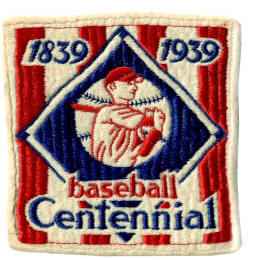 The
National Centennial Commission held
a contest to design an emblem for
the 100th anniversary of baseball
in the summer of 1938. Unveiled in
December, at the annual meeting of
the National Association of
Professional Baseball Leagues, the
winning design was awarded to New
York artist Majori
Bennet.
In commemoration of the 100th anniversary of organized baseball the
Official Insignia of Baseball’s
Centennial had been adopted for
flags which to be flown from all of
the parks.
The red, white and blue patch had four red stripes, symbolic of four
balls, three white stripes,
representing three strikes. A blue
diamond was superimposed on the
stripes, with a white baseball and
a batter completing a swing in the
diamond center. The design was used
on such items as stationary,
publications,
advertising, and uniform patches
worn by the players during the year.
However, the batter featured on the patch resembled Joe DiMaggio and Major
League Players objected to singling
out one player to represent the
Centennial of Baseball and refused
to wear the patch, so it was
redesigned.
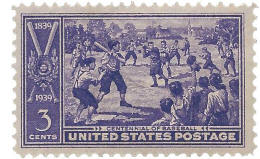
Soon after postmaster General James
A. Farley announced that the Post
office was planning to issue a
commemorative stamp in honor of
baseballs centennial, suggestions
started to flood in. The most
popular being Christy Mathewson.
The portraits of both Abner
Doubleday and Alexander Cartwright,
who were given credit at the time
for having introduced baseball into
this country, was also suggested.
Many thought John J. McGraw, who
managed the New York Giants for
many years should be honored.
Others suggested a photograph of
the National baseball Museum and
Doubleday field, both located at
Cooperstown, N.Y., should form the
principal feature of the stamp.
The chosen design for the stamp depicts a sandlot baseball game between
two boy's teams, with a pitcher
watching first base and about to
deliver the ball. To Within a
wreath, enclosed crossed bats, a
glove and a ball. In the background
a church and a schoolhouse with the
American flag flying from the
playground flagpole. It was
the first baseball postage stamp,
and it was issued by the U.S. Post
Office in Cooperstown, on June 12,
1939, to kick off baseball's
centennial celebration.
|
|
| |
 |
|
| |
The National Centennial
Commission granted the Leatherstocking
Stamp Club exclusive use of the
Centennial Emblem Design in the spring
of 1939 for their First Day of Issue
envelope and stationery in recognition
for their hard work to Lobby on behalf
of the Baseball Stamp. The Cooperstown
P.O. cancelled stamps on 398,199 "First
Day of Issue Covers" on June 12, 1939.
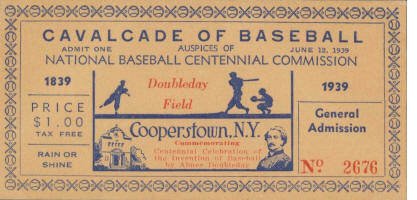 June 12, 1939, was also the climax, in
Commemorating the baseball centennial
celebration. The Cavalcade of Baseball
played at Cooperstown, New York, on the
diamond devised by Abner Doubleday when
he originated the game 100 years
earlier.
June 12, 1939, was also the climax, in
Commemorating the baseball centennial
celebration. The Cavalcade of Baseball
played at Cooperstown, New York, on the
diamond devised by Abner Doubleday when
he originated the game 100 years
earlier.
A sell-out crowd of more than 10,000 saw a team of National and American
League players selected by Honus Wagner
via the Choose-up" method, defeat a
team captained by Eddie Collins, 4-2 in
seven innings.
Tickets
offered by the National Baseball
Centennial Commission for the Game
ranged from .40˘ - $1.00 for Student
and General Admission, and $1.65 -
$2.20 for prime seats.
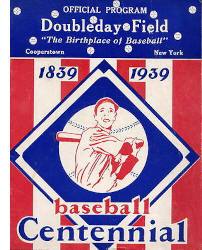 The
Official Doubleday Field Programs
for the Cavalcade of Baseball feature
the 1839-1939 baseball centennial
insignia on the cover. Forty pages
filled with photos, articles, and a
timetable of the various events that
took place that day.
The
Official Doubleday Field Programs
for the Cavalcade of Baseball feature
the 1839-1939 baseball centennial
insignia on the cover. Forty pages
filled with photos, articles, and a
timetable of the various events that
took place that day.
The Hall of Fame was established in 1936, but was dedicated in 1939. The
first four classes of inductees
gathered in 1939 for the first
induction weekend. The players that
attended that first weekend in 1939
were: Walter Johnson, Honus Wagner,
Babe Ruth, Eddie Collins, Connie Mack,
Cy Young, Grover Cleveland Alexander,
Tris Speaker, Napoleon Lajoie, and
George Sisler.
There are a number of variations of this program made for exhibition games
played throughout the year, which also involving
major league teams. The program was
also reproduced by the Hall of Fame,
which features a barcode on the back.
|
|
| |
 |
|
| |
Produced by the Dow Company,
these Hillerich & Bradsby Co.,
Louisville Slugger "Baseball's 100th
Anniversary" mechanical bat pencils
were made available for advertiser's to
promote their business. The dark
mahogany color wood bat pencils feature
a Louisville Slugger center brand with
"Baseball's 100th Anniversary" on the
barrel in gold. One of the most
successful promotions was with General
Mill's Wheaties Baseball's 100th
Anniversary, 10˘
box tops offer.
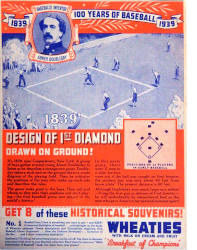 In 1939 to celebrate 100 years of
baseball,
Wheaties published "8 historical
highlights of baseball... printed
on the backs of Wheaties packages. "Neway"
descriptions and illustrations
depicting how baseball gloves
originated... How the Uniforms
developed...Evolution of the Bat. ..
and 5 other interesting highlights"
In 1939 to celebrate 100 years of
baseball,
Wheaties published "8 historical
highlights of baseball... printed
on the backs of Wheaties packages. "Neway"
descriptions and illustrations
depicting how baseball gloves
originated... How the Uniforms
developed...Evolution of the Bat. ..
and 5 other interesting highlights"
No. 1 - 1839 "Design Of First Diamond;" No. 2 - 1860 "Lincoln Gets News Of
Nomination On Ball Field;" No. 3 - 1869
"Crowd Boos First Baseball Glove;" No.
4 1877 "Curve Ball Just An Illusion Say
Scientists!;" No. 5 - 1877 "Fencers Mask
Is Pattern For First Catchers Cage;"
No. 6 - 1890 "Baseball Gets All Dressed
Up;" No. 7 - 1895 "Modern Bludgeon
Enters Game;" No. 8 - "Casey At The
Bat."
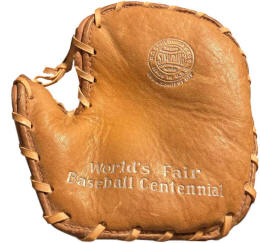 The Academy of Sports was a major
exhibit at the 1939 New York World’s
Fair. It was organized by Christy Walsh
who is known for acting as Babe Ruth's
agent, and is considered to be the
first baseball sports agent. Comprised
of 200 leaders in the sporting world,
the Academy of Sport sponsored baseball
clinics for youngsters. Instructors
that participated included; Babe Ruth,
Jimmie Foxx, Frank Frisch, Bob Feller,
Bill Dickey, Connie Mack, Leo Durocher,
and Joe Medwick.
The Academy of Sports was a major
exhibit at the 1939 New York World’s
Fair. It was organized by Christy Walsh
who is known for acting as Babe Ruth's
agent, and is considered to be the
first baseball sports agent. Comprised
of 200 leaders in the sporting world,
the Academy of Sport sponsored baseball
clinics for youngsters. Instructors
that participated included; Babe Ruth,
Jimmie Foxx, Frank Frisch, Bob Feller,
Bill Dickey, Connie Mack, Leo Durocher,
and Joe Medwick.
This
Spalding "World's Fair Baseball
Centennial" base mitt was one of
three types of souvenir baseball gloves
sold at the exhibit. There was also a
Catchers Mitt and fielders glove. A
Spalding mini-football souvenir that
features the 1939 World's Fair Trylon
and Perisphere logo was also sold at
the exhibit.
|
|
| |
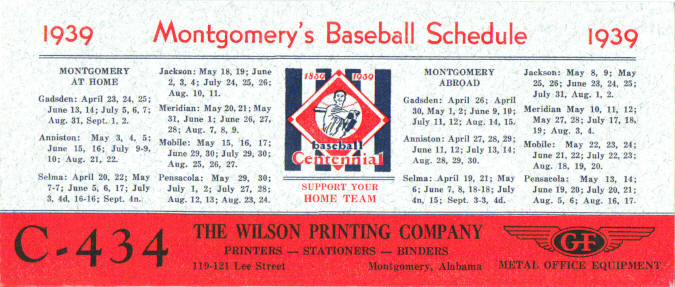 |
|
| |
This
1939 Montgomery
Rebels Minor League Baseball Schedule
ink blotter was produced by The
Wilson Printing Company in Montgomery,
Alabama. It features the 1939
Montgomery Rebels, Southeastern
League schedule, with the official
Insignia of baseball’s centennial in
the center.
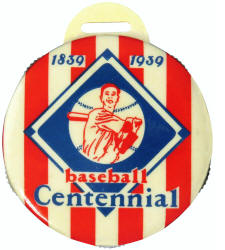 In celebration of baseballs 100th
birthday, Quaker offered free baseball
Gifts with Quaker Puffed Wheat and
Quaker Puffed Rice Box Tops. Given for
9 Box Tops or 1 Box Top and .15 cents,
you received this
Umpire's Watch FOB Score Indicator.
In celebration of baseballs 100th
birthday, Quaker offered free baseball
Gifts with Quaker Puffed Wheat and
Quaker Puffed Rice Box Tops. Given for
9 Box Tops or 1 Box Top and .15 cents,
you received this
Umpire's Watch FOB Score Indicator.
Easy to keep official score with 5 scoring dials; strikes, balls, innings,
and runs for both teams. The front of
the FOB has the Official Baseball
Centennial Souvenir design. The back
has an illustration of a baseball
diamond, with players and indicators.
The top edge has a small celluloid
extension with a slot for a leather
strap. Other premiums included;
Baseball Centennial Ring, given for 5
Box Tops or 1 Box Top and .10˘,
Baseball Centennial Charm Bracelet, 8
Box Tops or 1 Box Top and .15˘. The
offer was also available with Quaker
Corn Flakes.
|
|
| |
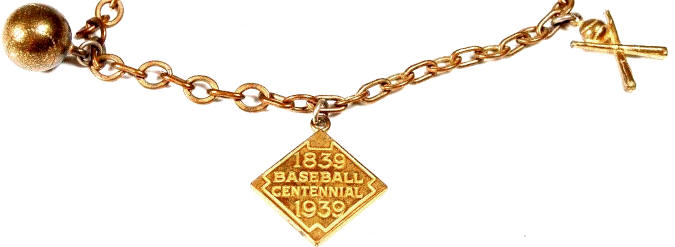 |
|
| |
As Advertised the
Baseball
Centennial Charm Bracelet is issued
once every 100 years. This smart
modern, gold-colored charm bracelet
commemorates baseball's 100 birthday.
Be the first to wear one. Exclusive
design. Order Now! Offer expired
October 1, 1939.
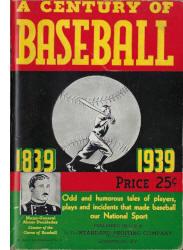 A Century of Baseball 1839-1939 by A.H.
Harvin was published by The Standard
Printing Co., Inc., Louisville, KY. The
book features "Odd and humorous tales,
of players, plays and incidents that
made baseball Our National Sport."
Stories and anecdotes include:
Baseball's First Scandal - Advent Of
The Catchers Mask - The First Game Of
Ball - Ruth Not First Home Run King,
and the Evolution of the Uniform.
A Century of Baseball 1839-1939 by A.H.
Harvin was published by The Standard
Printing Co., Inc., Louisville, KY. The
book features "Odd and humorous tales,
of players, plays and incidents that
made baseball Our National Sport."
Stories and anecdotes include:
Baseball's First Scandal - Advent Of
The Catchers Mask - The First Game Of
Ball - Ruth Not First Home Run King,
and the Evolution of the Uniform.
The cover pictures "Major-General Abner Doubleday, Creator Of the Game of
Baseball." Page 128 (last page)
Superstition: Not Politeness, is
followed by an order blank on the back
cover, which reads: "If You Enjoyed, "A
Century Of Baseball," Why Not Order A
Copy For Your Friends?, Where Can You
Find A Gift, That Will Be More
Appreciated, Cost Only 25c, __.__ Order
Today, From Your Local Newsdealer, or
Direct From Publisher, Order Blank
Inside"
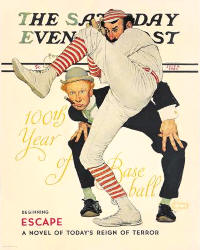 The
July 8, 1939 issue of The Saturday
Evening post
cerebrated the 100th Anniversary of
Baseball with this Norman Rockwell
illustration. The cover features a
pitcher in a 19th century uniform
along with great looking ankle high
athletic shoes.
The
July 8, 1939 issue of The Saturday
Evening post
cerebrated the 100th Anniversary of
Baseball with this Norman Rockwell
illustration. The cover features a
pitcher in a 19th century uniform
along with great looking ankle high
athletic shoes.
The glove with the
1 inch web was common to the 1910 -
1920s era, and goes against
Rockwell's reputation for attention
to accurate detail. In the early
days of baseball the umpire did
stand behind the pitcher so that
makes sense for this painting.
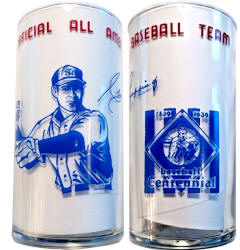 The Libbey Glass Co. produced ten
"Official All American Baseball Team"
milk glasses which were distributed by
the Esso Oil Co. The team was selected
by Babe Ruth's All America Board of
Baseball, in 1938, and used to
commemorate the 1839-1939 Baseball
Centennial.
The Libbey Glass Co. produced ten
"Official All American Baseball Team"
milk glasses which were distributed by
the Esso Oil Co. The team was selected
by Babe Ruth's All America Board of
Baseball, in 1938, and used to
commemorate the 1839-1939 Baseball
Centennial.
The ten glasses each depicted a ballplayer in blue, with the player's
facsimile autograph to the right. The
opposite side has the official
1839-1939 Baseball centennial emblem.
The players produced listed here as Babe Ruth's chosen batting order
were; Red Rolfe, 3B; Charlie
Gehringer, 2B; Joe DiMaggio, CF; Jimmie
Foxx, 1B; Mel Ott, RF; Joe Medwick, LF;
Ernie Lombardi, C; Joe Cronin, SS; Red
Ruffing, P; Paul Derringer, P.
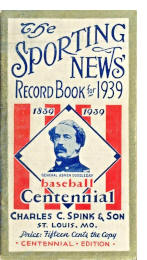 The Sporting News Record Book for 1939,
prepared by Ernest J. Lanigan was
published by Charles C. Spink & Son.
The 128 pages baseball record book
includes schedules, standings, a
detailed review of the previous
season's World Series, all-time World
Series results/records, Rosters, Minor League data and much
more.
The Sporting News Record Book for 1939,
prepared by Ernest J. Lanigan was
published by Charles C. Spink & Son.
The 128 pages baseball record book
includes schedules, standings, a
detailed review of the previous
season's World Series, all-time World
Series results/records, Rosters, Minor League data and much
more.
This edition also recaps Johnny Vander Meer's consecutive no-hitters and
features "Highlights of 100 Years."
General Abner Doubleday is pictured on
front cover. Great vintage advertising
for baseball gloves and other equipment
including a Louisville Slugger ad on
the back.
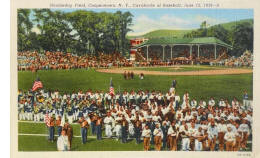 Sold in the National Baseball Hall Of
Fame's gift shop during the 1940s, this
standard size linen souvenir postcard
was produced to commemorate the
ceremonies held on Doubleday Field on
June 12, 1939.
Sold in the National Baseball Hall Of
Fame's gift shop during the 1940s, this
standard size linen souvenir postcard
was produced to commemorate the
ceremonies held on Doubleday Field on
June 12, 1939.
The
postcard produced by C. W. Huges & Co.
reads: "On this field in 1839 was
played the first game of baseball,
invented by Major General Abner
Doubleday of Civil War fame. Babe Ruth
and many other famous baseball players
were here for the cavalcade of
baseball, June 12, 1939"
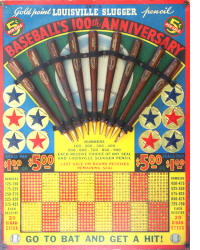 Punchboards, AKA; Novelty Trade Boards,
or Sales-boards, were gambling devices
which were commonly used in bars, or
country and five-and-dime stores as a
trade stimulator. In 1939, the Hamilton
MFG Co., of Minneapolis, Minnesota,
produced the
Baseball's 100th
Anniversary punch board.
Punchboards, AKA; Novelty Trade Boards,
or Sales-boards, were gambling devices
which were commonly used in bars, or
country and five-and-dime stores as a
trade stimulator. In 1939, the Hamilton
MFG Co., of Minneapolis, Minnesota,
produced the
Baseball's 100th
Anniversary punch board.
Baseball's 100th Anniversary 5˘ per sale punch board, features nine gold
point Louisville Slugger baseball bat
shape Mechanical pencils, attached at
the top. Punch out one of the 960 small
paper-filled holes with numbers
100-200-300-400-500-600-700-800, or 900
and receive your choice of any seal and
a Louisville Slugger Pencil. Each seal
pays out $1.00 or $5.00. Twenty prizes,
numbers 125 to 750, in intervals of 25,
each win 20 cigarettes.
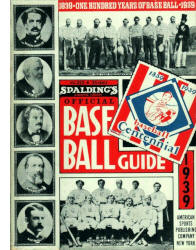 Part of Spalding's Athletic Library
(1895-1941)
the "Spalding's Official Base Ball
Guide" was published by A.G.
Spalding from 1877 to 1893, and from
1894 to 1941 by the American Sports
Publishing Company.
Part of Spalding's Athletic Library
(1895-1941)
the "Spalding's Official Base Ball
Guide" was published by A.G.
Spalding from 1877 to 1893, and from
1894 to 1941 by the American Sports
Publishing Company.
In 1934 Spalding bought out the Reach Company, who also published a
baseball guide, but the two guides
continued to be published separately
until 1939. Both the 1939 Spalding and
the Reach Official Baseball Guides
feature the Official Insignia of
Baseball’s Centennial, on the cover.
In 1940 and 1941, the American Sports Publishing Company published the
"Spalding-Reach Official Base Ball
Guide", after which it was replaced by
The Sporting News Baseball Guide. The
Sporting News Baseball Guide was
published every year from 1942 to 2006.
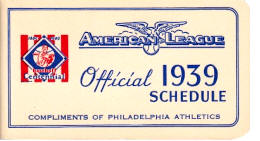 The
Official 1939 American League pocket
schedules were printed by The Fred
J. Ringley Co., of Chicago. They were
distributed at ballparks compliments of
each American League team printed at
the bottom. The cover features the
insignia of baseball’s
centennial.
The
Official 1939 American League pocket
schedules were printed by The Fred
J. Ringley Co., of Chicago. They were
distributed at ballparks compliments of
each American League team printed at
the bottom. The cover features the
insignia of baseball’s
centennial.
The back pictures a William Harridge official American League baseball and
reads: "-1939- The 100th anniversary of
baseball ... and the 40th consecutive
year the Reach Baseball has been the
official ball of the American League"
The 40 page booklet features six days
on each page with American League games
played that day for all eight teams.
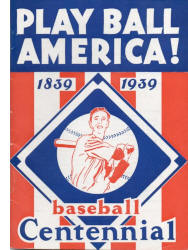 In 1939 The National Baseball
Centennial Commission published
"Play Ball America!" a 40 page book
on "How To Celebrate Baseball's 100th
Birthday In Your City." The cover
features the 1839-1939 Baseball
Centennial insignia.
In 1939 The National Baseball
Centennial Commission published
"Play Ball America!" a 40 page book
on "How To Celebrate Baseball's 100th
Birthday In Your City." The cover
features the 1839-1939 Baseball
Centennial insignia.
Page 2 features General Abner Doubleday. Page 3, a message of gratitude
for Abner Doubleday, from the President
of the United States, Franklin D.
Roosevelt. The book is divided into
nine innings, starting with the first
inning on page 5 - "Play Ball -
America!"
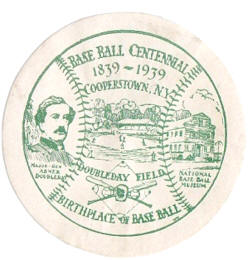 Poster Stamps were produced as an
advertising medium, used to promote an
event, and most were saved as a
souvenir, commemorating something. The
term Poster Stamp came about because
many of these stamps were “poster-like”
in their looks or even miniature copies
of full size street posters.
Poster Stamps were produced as an
advertising medium, used to promote an
event, and most were saved as a
souvenir, commemorating something. The
term Poster Stamp came about because
many of these stamps were “poster-like”
in their looks or even miniature copies
of full size street posters.
Alfred R. Cobbett, a member of the Centennial Committee for Advertising
and Publicity, created the Great Seal
in 1934 for the Cooperstown’s Base Ball
Centennial Committee’s Mast Head.
The great seal was used on letterheads, legal documents, first day cover
cachets, envelopes, souvenirs, and this
1839-1939 Baseball Centennial Doubleday Field Poster
Stamp. The design is center, from left to right,
has an illustration of Major-Gen. Abner
Doubleday, Doubleday Field, and the
Cooperstown National Base Ball Museum,
as labeled below each. The initials
"ARS" on the right, below the word
Ball, stands for Alfred R. Cobbett.
|
|
| |
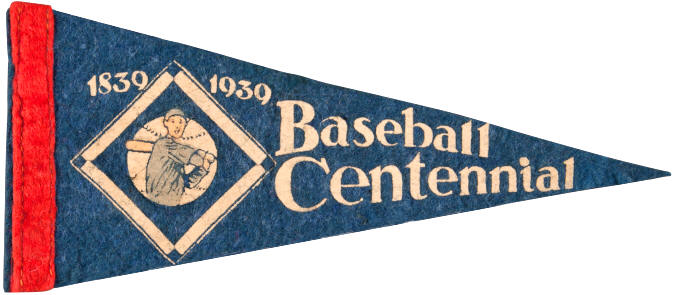 |
|
| |
1839-1939 Baseball Centennial Ballpark
Souvenir Pennant |
|
| |
|
|
| |
KEYMAN COLLECTIBLES
RELATED RESOURCES |
|
| |
|
|
| |
|
|
| |
|
|
| |
|
|
| |
KeyMan
Collectibles Collectors Corner
- Keep up with the latest collecting news,
announcements, and articles of interest on the
webs best resource for baseball memorabilia. |
|
| |
KeyMan Collectibles Baseball
Memorabilia Facebook Group -
Post Questions and comments relating to
Baseball Collectibles and Memorabilia. Interact
with other collectors or show off your
collection. |
|
| |
KeyMan Collectibles Forum
- A great option for those that "Don't do
facebook" Post Questions and
comments relating to Baseball Collectibles and
Memorabilia |
|
|


